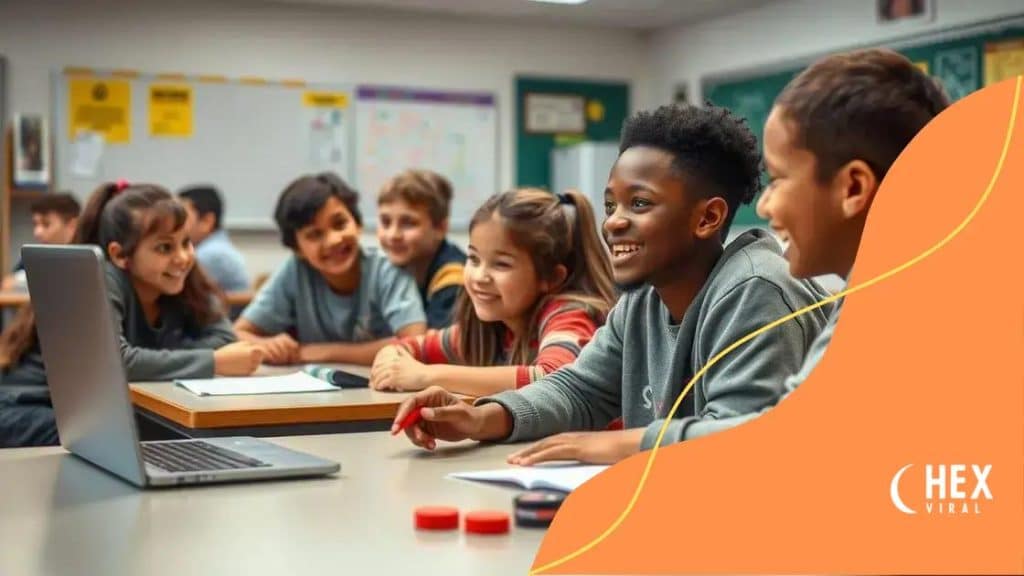Gamification in classrooms: engaging students through play

Gamification in classrooms enhances student engagement by incorporating game elements such as points, challenges, and rewards, leading to improved motivation and better learning outcomes.
Gamification in classrooms offers a unique way to engage students through play and interaction. Have you ever wondered how making lessons more game-like could improve attention and understanding? Let’s dive into this innovative approach!
Understanding gamification and its benefits
Understanding gamification and its benefits begins with recognizing its power to engage students effectively. This method incorporates game-like elements into learning, making education more enjoyable and interactive.
What is Gamification?
Gamification involves using game mechanics, such as scoring systems, competition, and rewards, to motivate students. This strategy can change how students approach their tasks and improve their overall learning experience.
Benefits of Gamification
- Enhances motivation by making lessons feel like games.
- Increases participation through challenges and rewards.
- Encourages collaboration among students during activities.
- Helps in developing problem-solving skills.
When students are more engaged, they experience better retention of the material. This engagement can lead to higher academic performance, creating a win-win situation in the classroom.
Furthermore, gamification allows teachers to personalize learning. By incorporating different games and activities, educators can cater to various learning styles and interests. Each student can progress at their own pace, which is crucial for effective learning.
In addition, as students work through gamified tasks, they often develop essential skills such as resilience and the ability to accept feedback. These experiences can be invaluable, preparing them for real-world challenges.
How game elements enhance learning
Understanding how game elements enhance learning involves recognizing the engaging aspects of games that can make education more exciting and effective. By incorporating aspects such as competition and rewards, teachers can motivate students and create a more dynamic learning environment.
Elements of Games in Education
Game elements can be as simple as scoring systems, levels, or achievements. These components can capture students’ attention and encourage them to strive for improvement.
- Points and Scoring: Students earn points for completing tasks, allowing them to visualize their progress.
- Levels: Different levels can represent mastery of concepts, motivating students to advance.
- Challenges: Presenting challenges makes learning feel like a quest, adding excitement.
- Rewards and Badges: Recognition through rewards can boost students’ confidence and encourage participation.
When students interact with gamified content, they often experience a sense of ownership over their learning. This ownership leads to increased persistence in completing tasks and willingness to explore new topics. Rather than viewing assignments as chores, students see them as challenges to conquer.
Moreover, gamification promotes collaboration among students. Many games require teamwork, and educators can implement group challenges to foster this spirit. As students work together, they develop crucial social skills while learning core subjects.
This blend of fun and education creates an atmosphere where students are more likely to participate. When learning feels like a game, students naturally become more involved in the material. They are more willing to take risks, ask questions, and engage in discussions, all of which enhance their understanding.
Implementing gamification in various subjects

Implementing gamification in various subjects can transform traditional lessons into engaging experiences. By applying game elements across diverse topics, teachers can captivate students and enhance their learning outcomes. Each subject can benefit from tailored gamification strategies.
Gamification in Mathematics
In math classes, teachers can use gamified challenges that involve solving problems to earn points or badges. This approach makes practicing math skills more appealing. For instance, a classroom game could involve earning rewards for completing complex equations or participating in group quizzes.
- Use math puzzles that unlock levels or badges.
- Incorporate team competitions to solve real-world problems.
- Create interactive quizzes with instant feedback.
In science classes, laboratory experiments can be turned into quests where students earn points for conducting successful experiments. This not only makes learning fun but also encourages hands-on involvement.
Gamification in Language Arts
For language arts, gamification can be utilized through storytelling and creative writing. Students can create a narrative that unfolds as they progress through different writing tasks. Rewarding them with points for innovative ideas or peer reviews encourages collaboration and creativity.
- Set up writing challenges based on prompts.
- Encourage reading by tracking books finished and rewarding milestones.
- Involve peer reviews for extra points, enhancing collaboration.
Additionally, in history classes, students can take part in role-playing games where they assume the identity of historical figures to solve problems or debates relevant to the period being studied. This immersive method promotes engagement and enhances understanding.
Implementing gamification in subjects requires creativity and adaptability. It’s essential to consider the interests of the students to develop appealing activities. By making learning enjoyable, students are more likely to engage deeply with the material and retain information.
Examples of successful gamification in classrooms
There are many examples of successful gamification in classrooms that demonstrate how effective this approach can be. By integrating game elements into lessons, teachers have seen increased student engagement and improved learning outcomes.
Case Study: Math Bingo
One popular method in math classes is through games like Math Bingo. In this activity, students answer math problems to fill up their bingo cards. They earn points for correct answers and compete to win small prizes. This lively setup encourages quick thinking and reinforces math skills.
- Students enjoy the competitive aspect of the game.
- It helps to reinforce key math concepts in a fun way.
- Instant feedback is provided through the game format.
Another exciting example is using digital badge systems in language arts classes. Students can earn badges for completing reading assignments or writing tasks. This not only motivates them to finish their work but also acknowledges their efforts. It creates a sense of accomplishment that encourages continued participation.
Classroom Quests in History
In history classes, teachers have implemented classroom quests where students role-play famous historical figures. They work together on projects to resolve issues from the past or simulate events. This immersive approach fosters collaboration and deepens their understanding of history.
- Creating a narrative allows students to connect with the material.
- They learn teamwork skills while having fun.
- Students are more likely to remember historical facts through engaging activities.
Lastly, science experiments can also be gamified. Teachers can set up lab simulations where students must solve problems to progress. Earning points for successful experiments encourages them to be more hands-on and creative in finding solutions.
These examples show how effective gamification can be across various subjects. Not only does it make learning more enjoyable, but it also helps students achieve their educational goals in a supportive environment.
Measuring the impact of gamification on student engagement
Measuring the impact of gamification on student engagement requires careful observation and analysis. Teachers can use various methods to assess how gamified elements affect students’ motivation and participation in the classroom.
Surveys and Feedback
One effective way to measure engagement is through surveys. After implementing gamification, teachers can ask students how they feel about their learning experience. Questions can cover aspects like enjoyment, motivation, and willingness to participate in class activities.
- Ask students to rate their interest in lessons.
- Gather feedback on specific gamified elements.
- Include open-ended questions for detailed responses.
Besides surveys, direct feedback during class discussions can also provide insight. When students express their thoughts about games or challenges, it reveals their level of interest and engagement.
Tracking Participation
Another method is tracking participation rates. Teachers can monitor attendance and involvement in gamified activities compared to traditional lessons. If students are more present and actively participating, it’s a strong indication that gamification is effective.
Data from participation can further highlight differences in performance. Examining grades, homework completion rates, and class involvement before and after gamification provides valuable metrics.
Observing behavior during activities is crucial too. Noting how students interact, collaborate, and respond to challenges can show how engaged they are with the material. Increased collaboration often indicates that students feel challenged yet supported in a gamified environment.
Cumulatively, these methods offer insights into how gamification impacts student engagement. By using a mix of surveys, tracking, and observation, educators can gauge the effectiveness of their strategies and adjust accordingly for better outcomes.
FAQ – Frequently Asked Questions about Gamification in Classrooms
What is gamification?
Gamification is the use of game elements in non-game contexts, like education, to enhance engagement and motivation.
How can gamification improve student learning?
It makes learning more interactive and enjoyable, helping students stay focused and retain information better.
What are some examples of gamification in classrooms?
Examples include Math Bingo, digital badge systems in language arts, and role-playing historical figures in social studies.
How can teachers measure the effectiveness of gamification?
Teachers can use surveys, participation tracking, and observation to assess student engagement and motivation after implementing gamification.






